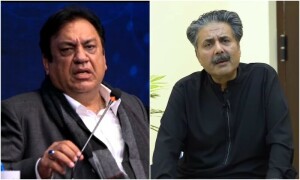ISLAMABAD: Some of the oldest Buddhist manuscripts in existence have been added to the collection at the Islamabad Museum, as well as the stone inscription of a 1,100 AD mosque in Udigram, Swat.
The 2,000-year-old Buddhist script is written on bark and was found buried inside terracotta jars. It was discovered by Sir John Hubert Marshall, the director general of the Archaeological Survey of India from 1902 to 1930.
Inside a glass box adjacent to the small pieces of bark sits a rock edict from the 5th to 7th century.
“These manuscripts are not only the oldest of any Buddhist tradition, but they are also the oldest manuscripts from the Gandhara region,” said museum director Dr Abdul Ghafoor Lone.
The Islamabad Museum’s collections represent the rich heritage of Pakistan, with artefacts from across the country. Among the pieces on display are the more than 7,000-year-old Mehergarh relics, two million year old hunting tools and artefacts from the Hindu, Muslim and British colonial period.
The collection of artefacts has grown from 312 to more than 800, including the recent addition of the famous 2nd to 5th century Bodhisattva, a rare red sand stone sculpture discovered in the excavation in Badalpur that is only one of two in the whole country.
“Red sand stone sculptures are not found in this region. This was probably a gift from India. Its features such as the drapery and the face of the seated Buddha and the peepal tree are more India-specific than Gandharan,” Dr Lone said.
Also added to the collection last week was the stone inscription on white marble from an 1,100 AD mosque in Udigram, Swat, believed to be built by Prince Abul Mansur. The inscription reads that the construction of this mosque and doors took place in the year 1048-1049.
According to Dr Lone, the mosque is a unique architectural work from the Ghazni period.
The tiny stupa shaped Relic Casket, from 200 BC to 200 AD discovered from Sirkap, Taxila, that survived massive fires have also been put on display.
According to Dr Lone, the Department of Archaeology and Museums is going to include more relics found from across the country. The museum, which is housed in the Sir Syed Memorial Building in G-5, will display them in its new gallery.
Published in Dawn, October 21st, 2019















































